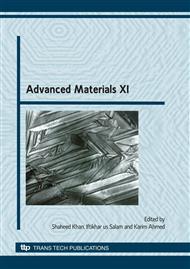p.211
p.221
p.227
p.236
p.242
p.250
p.255
p.263
p.268
Tuning of Gadolinium Based Compounds for Potential Application in Self-Controlled Hyperthermia Treatment of Cancer
Abstract:
We report on the synthesis and investigation of magnetic properties of several new Gd based alloys suitable for their potential use in self-controlled hyperthermia treatment of cancer. Self-controlled hyperthermia is a non-invasive technique that employs heating of magnetic materials (ferromagnetic bulk sized thermo-seeds or magnetic nanoparticles) in a. c. fields to cure cancer cells. Magnetic materials with Curie temperature (Tc) in the range of 40-46oC are desired, as decreased magnetic coupling in paramagnetic regime (above Tc) provides a safeguard against overheating of normal cells. The need for developing such materials was dictated by the lack of existing magnetic materials with magnetic ordering temperature in the suitable range of hyperthermia applications. This study shows that these materials have high magnetization values and their Tc values can be varied linearly over a broad range by adjusting the composition of the constituent elements.
Info:
Periodical:
Pages:
242-249
Citation:
Online since:
June 2010
Authors:
Keywords:
Price:
Сopyright:
© 2010 Trans Tech Publications Ltd. All Rights Reserved
Share:
Citation:


